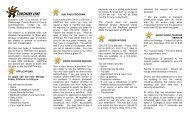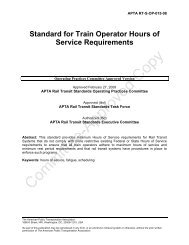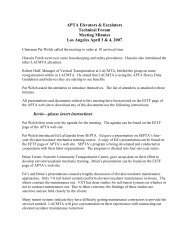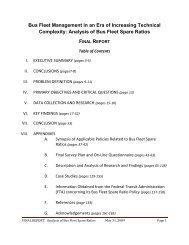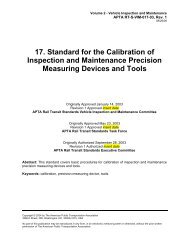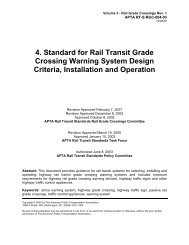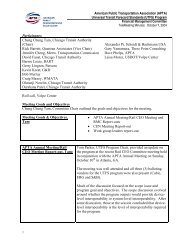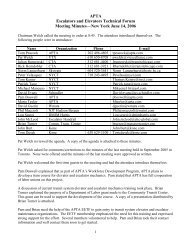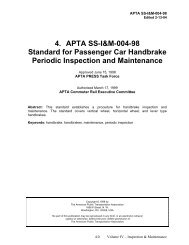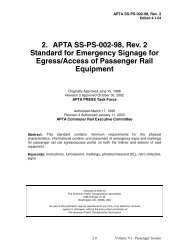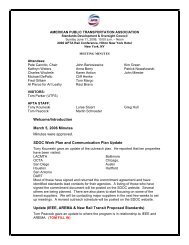Standard Bus Procurement Guidelines - APTAStandards.com
Standard Bus Procurement Guidelines - APTAStandards.com
Standard Bus Procurement Guidelines - APTAStandards.com
You also want an ePaper? Increase the reach of your titles
YUMPU automatically turns print PDFs into web optimized ePapers that Google loves.
<strong>Standard</strong> <strong>Bus</strong> <strong>Procurement</strong> <strong>Guidelines</strong><br />
The door control, kneel control, windshield wiper/washer controls, and run switch shall be in the most<br />
convenient operator locations. They shall be identifiable by shape, touch, and permanent markings.<br />
Doors shall be operated by a single control, conveniently located and operable in a horizontal plane by<br />
the operator's left hand. The setting of this control shall be easily determined by position and touch.<br />
Turn signal controls shall be floor-mounted, foot-controlled, waterproof, heavy-duty, momentary contact<br />
switches.<br />
All panel-mounted switches and controls shall be marked with easily read identifiers and shall be<br />
replaceable, and the wiring at these controls shall be serviceable from the vestibule or the operator's seat.<br />
Switches, controls, and instruments shall be dust- and water-resistant consistent with the bus washing<br />
practice described in Section 5.4.4.1.<br />
5.4.6.1.4 Door Control<br />
Operation of, and power to, the passenger doors shall be <strong>com</strong>pletely controlled by the operator. Doors<br />
shall open or close <strong>com</strong>pletely in not more than 3.5 seconds from the time of control actuation and shall<br />
be subject to the closing force requirements of Section 5.4.5.3.7 and the adjustment requirements of<br />
Section 5.4.5.3.8. The door control shall be a lever that rotates around a vertical staff. The level lever<br />
shall be located on the street side of the operator’s area approximately 16 inches to the street side of the<br />
operator’s seat centerline, forward of the seat, and approximately 23 inches above the floor in the<br />
operator’s area.<br />
A control or valve in the operator's <strong>com</strong>partment shall shut off the power to, and/or dump the power<br />
from, the front door mechanism to permit manual operation of the front door with the bus shut down. A<br />
master door switch which is not within reach of the seated operator when set in the "Off" position shall<br />
close the doors, deactivate the door control system, release the interlocks, and permit only manual<br />
operation of the doors.<br />
To preclude movement of the bus, an accelerator interlock shall lock the accelerator in the closed<br />
position and a brake interlock shall engage the service brake system when the rear door control is<br />
activated. The braking effort shall be adjustable with hand tools.<br />
5.4.6.1.5 Instrumentation<br />
The speedometer, air pressure gauge(s), and certain indicator lights shall be located on the front cowl<br />
immediately ahead of the steering wheel. The steering wheel spokes or rim shall not obstruct the<br />
operator's vision of the instruments when the steering wheel is in the straight-ahead position.<br />
Illumination of the instruments shall be simultaneous with the marker lamps. Glare or reflection in the<br />
windshield, side window, or front door windows from the instruments, indicators, or other controls shall<br />
be minimized. Instruments and indicators shall be easily readable in direct sunlight. Indicator lights<br />
immediately in front of the operator are identified in the following table.<br />
Technical Specifications 174 10/18/07



